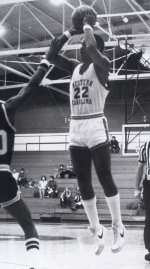- Attacking style not the only reason some Tottenham fans will back Ange Postecoglou until the bitter endPosted 4 months ago
- Paris Olympics takeaways: What did Team USA’s crunch-time lineup say about NBA’s hierarchy?Posted 9 months ago
- Zach Edey posted an easy double-double in Summer League debut. Here’s why he’ll succeed in NBAPosted 11 months ago
- What will we most remember these champion Boston Celtics for?Posted 11 months ago
- After long, seven-year road filled with excruciating losses, Celtics’ coast to NBA title felt ‘surreal’Posted 11 months ago
- South Florida men’s basketball is on an unbelievable heater– but also still on the bubblePosted 1 year ago
- Kobe Bufkin is balling out for Atlanta Hawks’ G League team. When will he be called up to NBA?Posted 1 year ago
- Former Knicks guards Immanuel Quickley, RJ Barrett may yet prove Raptors won the OG Anunoby tradePosted 1 year ago
- Rebounding savant Oscar Tshiebwe finally gets NBA chance he’s deserved for yearsPosted 1 year ago
- Is Tyrese Maxey vs. Tyrese Haliburton the next great NBA guard rivalry?Posted 2 years ago
College gym floors getting new paint jobs; 3-point arc is enlarged starting next season
- Updated: July 18, 2019
Those who have been complaining about the relative ease that 3-point shots have been made will be happy to learn that in college basketball’s Division I the 3-point arc will be enlarged starting this coming season.
It has until now and for several years measured 20 feet 9 inches. Starting in October it becomes 22 feet 1 3⁄4 inches, as established by the NCAA Rules Oversight Panel. This will correspond to the international distance.
The additional 1 foot 4 ¾ inches means that maintenance people at the various colleges will have to get out the scrapers, sanding machines, paint, brushes and sprayers, to redo the arc boundaries, fill in the exposed paint area, and obliterate or paint over the lines that have been already set down. Perhaps that work is already underway on some courts.
They will get a little more time to do it at Division II and Division III colleges. The change in the arcs will not take place at those schools until the 2020–21 season.
With women’s hoops, courts could become a confusing place
Until now the women’s game also had an arc of 20 feet nine inches, the same as the men. For the time being, that will stay the same. With the new dimensions going into effect for the men, there will now be two arcs on the surfaces that are used for both men’s and women’s games. The old arc will remain for the ladies, while the new one is being added for the men.
It will make for a hodgepodge of lines, especially on those floors that are also marked for volleyball and other indoor activities.
The NCAA Women’s Rules Committee is studying whether to follow the men’s new 3-point distance, but moving slowly. It is allowing colleges to experiment with it in exhibition games.
But at least for the coming basketball season, players, officials, scorers, and fans will have to distinguish between which arc to look at and which to ignore to know whether a made shot should be awarded two or three points.
Why the change?
The obvious effect of the new dimensions will be to make 3-pointers more difficult to knock down and possibly reduce the number of attempts. It should also open up the lane for driving to the basket and allow for more spreading on offense.
Ted Boyle, head coach at Colorado, is chairman of the NCAA panel. He explained, “After gathering information over the last two seasons, we feel it’s time to make the change. Freedom of movement in the game remains important as we feel this will open up the game. We believe this will remove some of the congestion on the way to the basket.”
Back in time
When the 3-pointer was originally approved for the 1986–87 season the lines were set at 19 feet 9 inches.
Edward Steitz, then the secretary-editor of the 12-member NCAA rules committee, and who was the athletic director at Springfield (Mass.) College at the time, predicted correctly it would force teams to play more defense away from the basket and that it would put the little man back in the game.
Other new rules
Enlarging the men’s 3-point arc is perhaps the most significant rule change going into effect this year, or at least it’s the one that will be most apparent to players and fans. Another change will be to reset the shot clock to 20 seconds after an offensive rebound. Also, during the final two minutes of a game and overtime, coaches may be granted replay reviews for basket interference or goal-tending.
John Cahill of Fordham made the first 3-pointer in 1945
According to The Brooklyn Daily Eagle of Feb. 8, 1945, the first 3-point basket ever made, although not in the rule book, came from John Cahill of Fordham in a game against Columbia. It had a 21 foot arc, but was only in an experimental contest that included other rule and scoring changes. Columbia won on its home court, 73-58, making 11 from long range, while Fordham made nine.
There were two other experimental games. In 1958 St. Francis (N.Y.) and Siena used a 23 foot line, and in 1961 Boston University and Dartmouth credited all field goals from any distance in their game good for three points.
Ronnie Carr’s, Western Carolina, claim to fame

Ronnie Carr of Western Carolina officially knocked down the first 3-pointer in NCAA men’s basketball history, shown in this photo. (CBS/CSTV)
In addition to John Cahill, the name Ronnie Carr should be noted when it comes to 3-pointers. In the 1980–81 season the NCAA’s Southern Conference became the initial collegiate league, and one of just two, permitted to use a three-point rule. Carr, a member of the Western Carolina Catamounts quintet of Cullowhee, NC, earned his claim to fame by becoming the very first to score a three-point basket in a regulation college basketball game.
The line was then set at 22 feet, when he first connected for one 39 years ago (Nov. 29, 1980) in his team’s 77-70 win over Middle Tennessee. By coincidence, he was also wearing number 22.
His shot was a 23-footer from the left wing at Western’s Reid Gym with 16:09 left in the first half.
Carr also played as a freshman, the year before the shot was sanctioned.
Carr only took 39 treys during his 1980–81 season, making 15. The following year, he only took 11 and made eight. He did not play as a senior due to injuries.
Over the following five years, the NCAA allowed different conferences to use the rule at various distances. It was ultimately put into effect for all NCAA games at 19 feet 9 inches starting with the 1986–87 season.
Coach K didn’t like it; Larry Brown saw some merit
Interestingly, two future coaching greats gave differing opinions about the innovation. Mike Krzyzewski, who had just started his reign at Duke, was quoted in the New York Times of April 2, 1986, as being flatly opposed:
“This is a revolutionary change, and I don’t think it’s good for the game right now. There are a lot of major coaches shocked by this. If we’re shocked, then you know there hasn’t been a lot of discussion about it, and certainly there has been no public outcry to implement a 3-point shot.”
But Larry Brown, then coaching at Kansas, said otherwise, according to the same article:
“I think the 3-pointer has merit. I’m a little confused about the distance. I don’t want it to be such an easy shot that it really becomes more important than anything, because I don’t think that’s the purpose. I do think it’ll open the game up a little more and we probably won’t see as many zones.”
Update to 2019
Mike Krzyzewski must feel differently about the trey today. The 3-point field goal is now so well established that we hear nothing about abolishing it. But the distances have been tweaked a few times, such as for the coming season. Shooting from downtown will still be worth three points. But “how far away is downtown” has again been changed.
Other sports are more consistent. In baseball we expect there will always be 90 feet between the bases (including home plate). Football fields are and probably will long continue to have 100 yards from goal line to goal line. But in basketball the lines in the arcs are ever moving. Players will again have to adjust. Fans will see things differently.
So let the painting begin.




